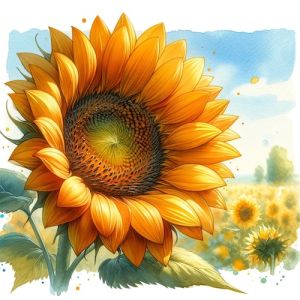Hello my fellow gardeners! Today we explore the sunny world of sunflowers, a delightful addition to any garden. Known for their vibrant colors and towering presence, sunflowers bring joy and warmth to any landscape. In this guide, we’ll delve into everything you need to know to cultivate these cheerful blooms successfully.
Sunflower Overview
- Common Names: Sunflower
- Scientific Name: Helianthus annuus
- Family: Asteraceae
Sunflowers, scientifically known as Helianthus annuus, are annual flowering plants cherished for their large, daisy-like flowers and tall, sturdy stems. Native to North America, sunflowers have become popular globally for their aesthetic appeal and various uses, from ornamental gardening to agricultural purposes.
Native Habitat and Origin
Sunflowers are native to North America, primarily found in regions with abundant sunlight and well-drained soil. They thrive in areas with long, hot summers and moderate water availability. Historically, Native American tribes cultivated sunflowers for food, oil, and ceremonial purposes.
History of Cultivation
Native Americans cultivated sunflowers over 3,000 years ago, utilizing them for their seeds and oil. European explorers introduced sunflowers to the rest of the world in the 16th century. Since then, sunflowers have gained widespread popularity as ornamental plants and agricultural crops.
Popular Cultivars
- ‘Giant Russian’: Known for its enormous flower heads and robust growth habit.
- ‘Lemon Queen’: Boasts pale yellow petals and a compact growth form, ideal for smaller gardens.
- ‘Autumn Beauty’: Features a diverse range of colors, from deep reds to vibrant oranges and yellows.
- ‘Moulin Rouge’: Showcases deep burgundy petals with dark centers, adding a dramatic flair to any garden.
- ‘Teddy Bear’: A dwarf variety with fluffy, pollenless flowers, perfect for containers and borders.
Where to Find Seeds
Sunflower seeds are readily available at garden centers, nurseries, and online seed suppliers. Look for reputable sources that offer a wide selection of sunflower cultivars suited to your growing conditions.
Zones and Growing Conditions
Sunflowers thrive in USDA hardiness zones 1 through 11, depending on the variety. They prefer full sun exposure and well-drained soil with moderate moisture levels. While they are relatively adaptable, they perform best in climates with warm summers and ample sunlight.
Planting and Care
- Planting Time: Sow sunflower seeds directly into the garden after the last frost date, typically in late spring.
- Spacing: Space sunflower seeds or seedlings 6 to 18 inches apart, depending on the variety’s mature size.
- Soil Preparation: Choose a sunny location with fertile, well-draining soil. Amend heavy clay or sandy soil with organic matter to improve texture and fertility.
- Watering: Keep the soil consistently moist but not waterlogged, especially during the germination and flowering stages.
- Fertilization: Sunflowers are relatively low-maintenance and do not require heavy fertilization. However, applying a balanced fertilizer during planting can promote healthy growth.
- Support: Tall varieties may require staking or support to prevent bending or toppling in windy conditions.
Harvesting and Maintenance
- Harvesting Seeds: Allow sunflower heads to mature on the plant until the back of the flower head turns brown and the seeds develop a dark color. Cut the heads and hang them upside down in a well-ventilated area to dry. Once dry, remove the seeds for snacking or planting.
- Deadheading: Remove spent flowers regularly to prolong the blooming period and encourage continuous flowering.
- Pest and Disease Control: Monitor for common pests such as aphids and caterpillars, and treat as needed with organic or chemical controls. Watch for signs of fungal diseases, especially in humid conditions, and provide adequate airflow to prevent outbreaks.
Benefits and Uses
- Ornamental Value: Sunflowers add a cheerful pop of color to gardens and landscapes, attracting pollinators and beneficial insects.
- Edible Seeds: Sunflower seeds are a nutritious snack and can be used in cooking, baking, and salads.
- Cut Flowers: Harvest sunflowers for stunning floral arrangements and bouquets, bringing the beauty of the garden indoors.
Conclusion
Sunflowers are not only a symbol of sunshine and happiness but also versatile plants that offer beauty, utility, and ecological benefits. By following the tips and guidelines outlined in this guide, you can successfully grow and enjoy these iconic flowers in your own garden.
Embrace the radiance of sunflowers and watch as they brighten your outdoor space with their vibrant blooms and uplifting presence. Happy gardening!
Recent Posts

The Power of Mounding: An Essential Gardening Technique for Healthy Plants

The Ultimate Guide to Philodendron Birkin – Care, Tips, and Benefits

Watering Plants – Indoor Edition

The Advantages of Built-Up Garden Beds: A Gardener’s Best Friend

The Secret Weapon for Lush Blooms: How to Create the Perfect Fertilizer Schedule










